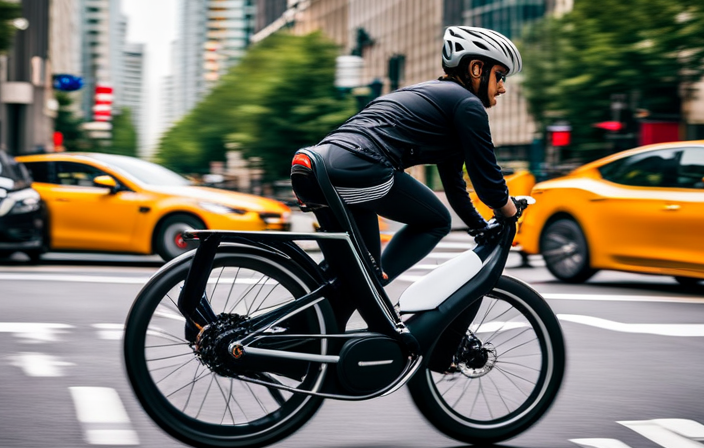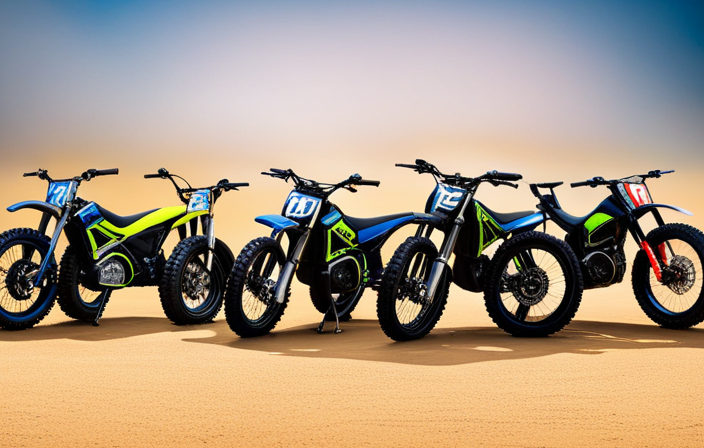Are you ready for the ride of a lifetime? Imagine an electric bike that can take you on an epic journey without ever running out of juice. That’s right, I’m talking about an electric bike with an incredible range that will blow your mind.
In this article, I will delve into the fascinating world of electric bike range, exploring the latest battery technology, assessing your riding needs, and uncovering the secrets to optimizing your bike’s range.
Get ready to go the distance and leave range anxiety in the dust.
Key Takeaways
- Battery capacity, power consumption, terrain, headwinds, and battery condition all affect the range of an electric bike on a charge.
- Advances in battery technology have resulted in longer-lasting charges and improved efficiency.
- The type of battery (lithium-ion, nickel-metal hydride, lithium polymer) impacts both the range and charging time of an electric bike.
- Planning for range and fitness goals is important, including considering commute distance, longer trips, and tailoring exertion levels through power modes.
Understanding Electric Bike Range
An electric bike’s range depends on various factors, such as battery capacity and terrain. Assessing battery capacity is crucial in understanding how far an electric bike can go on a single charge. The battery capacity is typically measured in watt-hours (Wh) and higher capacity batteries can provide a longer range.
Additionally, power consumption plays a significant role in determining the range of an electric bike. Factors such as the rider’s weight, speed, and level of pedal assist can impact power consumption. Riding on hilly terrains or against strong headwinds requires more power, reducing the overall range. It’s important to consider these factors when estimating the range of an electric bike.
Moving onto the subsequent section about the latest battery technology, advancements in battery technology have allowed for longer ranges and more efficient power consumption.
The Latest Battery Technology
With the latest battery technology, you can determine how long your e-bike’s charge will last. Battery longevity and charging efficiency play a crucial role in maximizing your riding experience. New advancements in battery technology have allowed for longer-lasting charges and improved efficiency, giving riders the confidence to tackle longer distances without worrying about running out of power. To understand the impact of these advancements, let’s take a look at the following table:
| Battery Type | Range (Miles) | Charging Time (Hours) |
|---|---|---|
| Lithium-ion | 50 | 4 |
| Nickel-metal hydride | 40 | 6 |
| Lithium polymer | 60 | 3 |
As you can see, the type of battery used in your e-bike can significantly affect its range and charging time. Assessing your riding needs will help you make an informed decision about the battery type that suits you best.
Assessing Your Riding Needs
When assessing my riding needs, I first determine my daily commute distance. This data is crucial in selecting an electric bike that can cover my regular travel needs without requiring frequent recharging.
Additionally, I consider planning for longer trips, such as weekend getaways or day trips, and ensure my electric bike has the range required to comfortably reach my destination and return.
Finally, I take into account my fitness level and choose an electric bike that offers varying levels of assistance, allowing me to tailor the level of exertion to my preference and ultimately improve my overall fitness.
Determining Your Daily Commute
Calculating your daily commute is essential in determining the range of an electric bike on a single charge. To assess your commute distance, consider alternative transportation options such as public transit or carpooling.
Here are three factors to consider in determining your daily commute:
-
Distance: Measure the distance between your home and workplace. This will give you an idea of how far you’ll need to travel on your electric bike.
-
Terrain: Take into account the type of terrain you’ll encounter during your commute. Hilly routes may require more battery power compared to flat routes.
-
Weather conditions: Consider the weather conditions in your area. Riding against strong headwinds or in heavy rain may decrease the battery range.
By analyzing these factors, you can estimate the range of your electric bike for your daily commute. Planning for longer trips can be done by considering additional charging points and alternative routes.
Planning for Longer Trips
To plan for longer trips, it’s important to consider additional charging points and alternative routes. When it comes to electric bikes, planning strategies play a crucial role in ensuring a smooth and uninterrupted journey.
One key aspect to consider is battery capacity optimization. By understanding the range of your electric bike and its battery life, you can plan your route accordingly. Look for charging points along the way to ensure you have enough power to complete your trip.
Additionally, consider alternative routes that may have a lower energy demand, such as avoiding steep hills or opting for more efficient paths. By strategically planning your trip, you can maximize the distance you can travel on a single charge.
Taking these factors into account will help you plan for longer trips and ensure a successful ride. Considering your fitness level, it’s important to choose a route that aligns with your physical capabilities.
Considering Your Fitness Level
Take into consideration your fitness level when planning your route. Riding an electric bike offers numerous fitness benefits, but the level of workout intensity you experience depends on your own effort.
Electric bikes have different power modes that allow you to adjust the level of assistance provided. By choosing a lower power mode, you can increase the effort required and get a more intense workout. This personalized workout intensity is ideal for individuals who want to gradually improve their fitness level. It allows you to start at a comfortable level and gradually increase the intensity as you become more comfortable with riding.
Considering your fitness level when planning your route ensures that you can optimize your electric bike’s range while also reaping the fitness benefits it offers.
Optimizing Your Electric Bike’s Range
Increasing your electric bike’s range is possible by optimizing its performance. Here are some ways to maximize your electric bike’s range:
-
Regularly maintain your electric bike: Keeping your bike in good condition, such as checking the tire pressure, lubricating the chain, and ensuring the brakes are working properly, can help improve efficiency and extend the range.
-
Choose eco-friendly transportation: Electric bikes are already a greener alternative to traditional vehicles, but you can further reduce your carbon footprint by using your electric bike for short trips instead of driving a car.
-
Ride at a consistent speed: Avoid sudden accelerations and decelerations, as they can drain your battery quickly. Instead, maintain a steady speed to optimize your electric bike’s efficiency.
-
Use pedal-assist wisely: Utilize the pedal-assist feature when necessary, such as when climbing hills or against strong headwinds. This way, you can conserve battery power and extend your electric bike’s range.
By implementing these strategies, you can significantly increase the range of your electric bike.
Now, let’s explore range-boosting accessories to further maximize your electric bike’s performance.
Exploring Range-Boosting Accessories
Check out these range-boosting accessories that can help you get more out of your electric bike.
When it comes to maximizing efficiency and extending the range of your electric bike, there are a few strategies you can employ.
First, consider investing in a lightweight and aerodynamic bike frame, as this can greatly reduce drag and increase overall efficiency.
Additionally, upgrading to high-capacity batteries or adding an extra battery pack can significantly extend your bike’s range.
Another option is to install regenerative braking systems, which can recover energy when you apply the brakes and use it to recharge the battery.
Lastly, equipping your bike with low-resistance tires and efficient gearing systems can further enhance its range.
By incorporating these range-boosting accessories and implementing range extending strategies, you can enjoy longer rides on your electric bike.
Now, let’s explore some real-life range examples.
Real-Life Range Examples
In my exploration of real-life range examples, I will discuss three key points: city commuting scenarios, off-road adventures, and long-distance touring.
These scenarios provide a comprehensive understanding of how far an electric bike can go on a single charge. By analyzing data from different situations, we can gain insight into the practicality and versatility of electric bikes for various purposes.
City Commuting Scenarios
You can easily determine how far an electric bike will go on a charge during your city commuting scenarios. By assessing battery capacity and comparing range efficiency, you can make an informed decision before setting out on your daily commute.
Here are four factors to consider:
-
Terrain: The type of terrain you’ll be riding on can greatly impact the range of your electric bike. Hilly areas require more power, reducing the overall distance you can travel.
-
Speed: Riding at higher speeds consumes more battery power. If you tend to ride at a faster pace, you may need to recharge more frequently.
-
Weight: The weight of both the rider and any additional cargo can affect the range. Heavier loads require more energy to propel forward, reducing the distance you can travel.
-
Battery Condition: The age and condition of your battery can also impact the range. As a battery ages, its capacity may decrease, resulting in a shorter distance on a single charge.
Considering these factors will help you determine the range of your electric bike for your city commuting needs.
In the next section, we’ll explore off-road adventures and what to consider for those thrilling rides.
Off-Road Adventures
When venturing on off-road adventures, it’s important to consider a few key factors. One of the most important factors is trail maintenance. Off-road trails can be rugged and challenging, so it’s crucial to ensure that the trails are well-maintained and suitable for electric bikes. This includes clearing any debris, repairing any damage, and marking any potential hazards.
Additionally, safety gear is essential when riding off-road. Helmets, knee pads, and elbow pads are just a few examples of the gear that can protect riders from potential injuries.
By taking these factors into consideration, off-road adventures can be both thrilling and safe.
Moving forward to the topic of long-distance touring, it’s important to note that electric bikes have the potential to travel impressive distances on a single charge.
Long-Distance Touring
For those looking to embark on long-distance tours, it’s worth noting that electric bikes have an impressive range on a single battery. With advances in battery technology, electric bikes can now travel up to 100 miles on a single charge, depending on various factors such as terrain, rider weight, and assist level. To put it into perspective, a traditional road bike typically covers around 30-40 miles on the same amount of effort. Electric bikes also require minimal maintenance compared to their gasoline counterparts, making them perfect for long journeys where bike maintenance may be challenging. Additionally, the growing network of charging stations across the country ensures that riders can easily find a place to charge their bikes and extend their range. Moving forward, let’s explore the various charging options and timeframes available for electric bike users.
Charging Options and Timeframes
To maximize your electric bike’s range, it’s important to consider the various charging options and timeframes available.
One important factor in determining the range of an electric bike is the battery capacity. Different bikes have different battery capacities, with some offering larger batteries that can store more energy. This means that bikes with larger battery capacities can travel further on a single charge compared to bikes with smaller battery capacities.
When it comes to charging options, there are a few different options available. Most electric bikes come with a standard charger that can be plugged into a regular household outlet. This is the most common and convenient option for charging your bike. However, there are also faster charging options available, such as using a dedicated electric bike charging station or investing in a fast charger. These options can significantly reduce the charging time and allow you to get back on the road more quickly.
Now, let’s discuss how to overcome range anxiety and ensure you never run out of battery power during your rides.
Overcoming Range Anxiety
Don’t worry about running out of battery power on your electric bike – there are ways to overcome range anxiety. One of the key strategies is maximizing battery life. By adopting certain habits and using efficient charging techniques, you can extend the distance you can travel on a single charge. To help you understand the potential range of an electric bike, consider the following table:
| Factor | Impact | Tips |
|---|---|---|
| Terrain | Hilly areas can drain the battery faster | Opt for flatter routes whenever possible |
| Speed | Higher speeds decrease range | Maintain a steady, moderate pace |
| Assist level | More assistance consumes more power | Adjust the assist level according to your needs |
By following these tips, you can overcome range anxiety and confidently enjoy your electric bike rides. Looking ahead to the future of electric bike range, advancements in battery technology and charging infrastructure will further enhance the capabilities of these bikes.
The Future of Electric Bike Range
Battery technology innovations, such as advancements in lithium-ion batteries, are playing a crucial role in the future of electric bike range. These innovations are allowing for longer-lasting batteries that can provide more power and extended range.
Additionally, the development of long-range electric bikes is also contributing to the future of electric bike range, with models now available that can travel over 100 miles on a single charge.
Lastly, the ongoing infrastructure development, including the expansion of charging stations, is further supporting the growth and adoption of electric bikes, making it easier for riders to travel longer distances without range anxiety.
Battery Technology Innovations
The advancements in battery technology have greatly improved the range of electric bikes. Battery efficiency has increased significantly, allowing for longer rides on a single charge. With the development of new battery technologies, electric bikes can now go farther than ever before. Range estimation has also become more accurate, giving riders a better idea of how far they can travel on their electric bikes. To illustrate the improvements in battery technology, consider the following table:
| Battery Type | Range (miles) | Charge Time (hours) |
|---|---|---|
| Lithium-ion | 50 | 4 |
| Nickel-metal | 30 | 3 |
| Lithium-poly | 60 | 5 |
As you can see, lithium-poly batteries offer the longest range, allowing riders to go up to 60 miles on a single charge. This increase in range opens up new possibilities for long-distance rides and commuting. With these advancements, long-range electric bikes are becoming increasingly popular and accessible.
Long-Range Electric Bikes
Long-range electric bikes have made it possible for riders to travel longer distances on a single charge. Electric bike efficiency plays a crucial role in determining the range that can be achieved.
Factors such as the battery capacity, motor power, weight of the bike, and terrain all affect how far an electric bike can go. Advances in battery technology have led to the development of more efficient batteries with higher energy densities, allowing for longer rides.
Additionally, the use of regenerative braking systems can help extend the range by converting kinetic energy into electrical energy and storing it back in the battery.
As electric bike technology continues to improve, riders can expect even greater range capabilities. With infrastructure development, such as the establishment of charging stations, riders will have more opportunities to explore and enjoy longer rides.
Infrastructure Development
To extend your riding experience, you need to consider the development of infrastructure such as the establishment of charging stations. As electric bikes become more popular, the need for a comprehensive charging network is crucial.
In order to facilitate the growth of electric bike usage in cities, the concept of smart cities has emerged. Smart cities integrate technology and infrastructure to improve the quality of life for their residents. One aspect of this is the implementation of charging stations for electric bikes. These stations provide a convenient and accessible way for riders to recharge their bikes while they go about their daily activities.
With the increasing number of charging stations in cities, electric bike riders can confidently venture further knowing that they have the support they need.
In conclusion, the development of charging stations is a key factor in the widespread adoption of electric bikes. By investing in this infrastructure, cities can encourage more people to switch to electric bikes, reducing traffic congestion and pollution.
Conclusion and Final Thoughts
Overall, it seems that electric bikes have a decent range on a single charge. With the continuous infrastructure development and advancements in battery technology, the limitations of electric bikes are being overcome, allowing for longer distances to be covered. Battery efficiency improvements have played a crucial role in extending the range of electric bikes. Manufacturers are investing in research and development to enhance battery performance, resulting in longer-lasting charges and increased mileage. These advancements have made electric bikes a viable option for daily commuting and longer rides.
However, it is important to note that the range of an electric bike can vary depending on various factors such as terrain, rider weight, and speed. Hilly terrains and heavier riders may consume more battery power, reducing the overall range. Additionally, riding at higher speeds can also drain the battery faster. Therefore, it is essential for riders to be aware of these factors and plan their journeys accordingly.
In conclusion, the electric bike industry has made significant progress in extending the range of bikes on a single charge. Overcoming limitations and battery efficiency improvements have paved the way for longer rides and increased usability. As technology continues to evolve, we can expect even further improvements in the future, making electric bikes an increasingly practical and sustainable mode of transportation.
Frequently Asked Questions
Can I use a regular bike charger to charge my electric bike?
Yes, you can use a regular bike charger to charge your electric bike, but it is not recommended. Using a dedicated electric bike charger offers benefits such as faster charging times and better compatibility with the battery.
How long does it take to fully charge an electric bike battery?
Charging time for an electric bike battery varies. On average, it takes 4-6 hours to fully charge. Factors like battery capacity, charger output, and initial charge level can affect the charging time.
Is it possible to ride an electric bike without using any battery power?
Yes, it is possible to ride an electric bike without using any battery power by utilizing riding techniques and energy-saving tips. These include pedaling more, using lower power modes, and avoiding unnecessary acceleration.
Are there any accessories that can help increase the range of an electric bike?
There’s an accessory that can boost an electric bike’s range beyond imagination. By investing in a state-of-the-art battery extender, you can ensure your electric bike never runs out of juice, allowing for endless adventures on the road.
Can the range of an electric bike be affected by weather conditions?
Temperature and wind can both significantly affect the range of an electric bike. Cold temperatures can decrease battery efficiency, while strong headwinds can increase resistance and drain the battery faster.
Conclusion
After delving into the intricacies of electric bike range, it is clear that the future holds great promise for this mode of transportation.
With advancements in battery technology and the availability of range-boosting accessories, electric bikes are becoming more efficient and capable of traveling longer distances on a single charge.
While range anxiety may still exist for some, it is important to remember that with careful planning and optimization, one can overcome this hurdle.
So, fear not, for the horizon of endless electric bike adventures lies just ahead.









